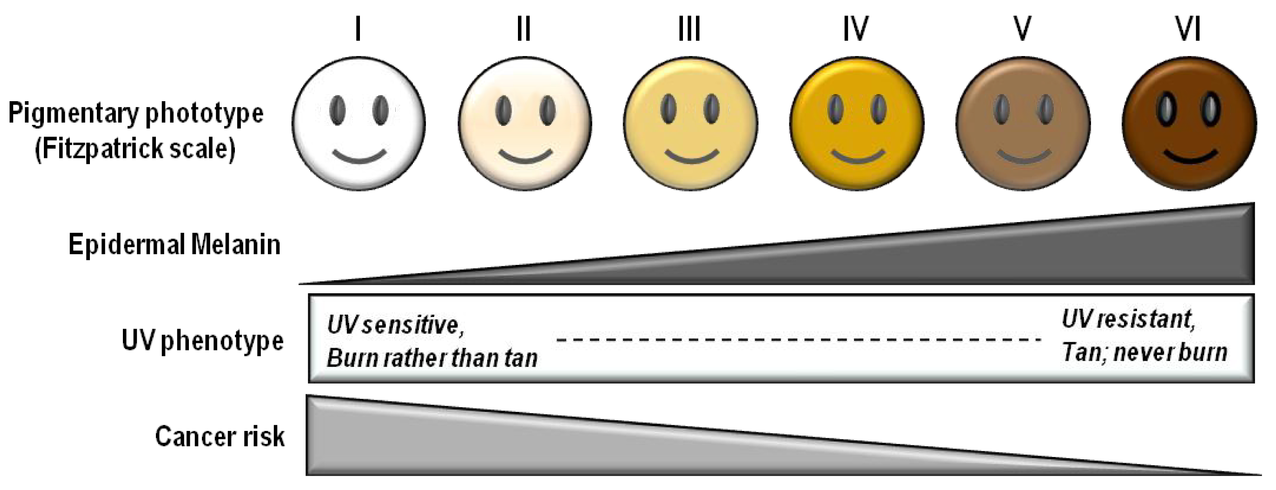|
Freckle
Freckles are clusters of concentrated melaninized cells which are most easily visible on people with a fair complexion. Freckles do not have an increased number of the melanin-producing cells, or melanocytes, but instead have melanocytes that overproduce melanin granules (melanosomes) changing the coloration of the outer skin cells (keratinocytes). As such, freckles are different from lentigines and moles, which are caused by accumulation of melanocytes in a small area. Freckles can appear on all types of skin tones. Of the six Fitzpatrick skin types, they are most common on skin tones 1 and 2, which usually belong to North Europeans. However, it can also be found on people all over the world. Biology The formation of freckles is caused by exposure to sunlight. The exposure to UV-B radiation activates melanocytes to increase melanin production, which can cause freckles to become darker and more visible. This means that one who has never developed freckles may develop them ... [...More Info...] [...Related Items...] OR: [Wikipedia] [Google] [Baidu] |
Melanocortin 1 Receptor
The melanocortin 1 receptor (MC1R), also known as melanocyte-stimulating hormone receptor (MSHR), melanin-activating peptide receptor, or melanotropin receptor, is a G protein–coupled receptor that binds to a class of pituitary peptide hormones known as the melanocortins, which include adrenocorticotropic hormone (ACTH) and the different forms of melanocyte-stimulating hormone (MSH). It is coupled to Gαs and upregulates levels of cAMP by activating adenylyl cyclase in cells expressing this receptor. It is normally expressed in skin and melanocytes, and to a lesser degree in periaqueductal gray matter, astrocytes and leukocytes. In skin cancer, MC1R is highly expressed in melanomas but not carcinomas. MC1R is one of the key proteins involved in regulating mammalian skin color and hair color. It is located on the plasma membrane of specialized cells known as melanocytes, which produce the pigment melanin through the process of melanogenesis. It works by controlling the ty ... [...More Info...] [...Related Items...] OR: [Wikipedia] [Google] [Baidu] |
Skin Pigmentation
Human skin color ranges from the darkest brown to the lightest hues. Differences in skin color among individuals is caused by variation in pigmentation, which is the result of genetics (inherited from one's biological parents and or individual gene alleles), exposure to the sun, natural and sexual selection, or all of these. Differences across populations evolved through natural or sexual selection, because of social norms and differences in environment, as well as regulations of the biochemical effects of ultraviolet radiation penetrating the skin. The actual skin color of different humans is affected by many substances, although the single most important substance is the pigment melanin. Melanin is produced within the skin in cells called melanocytes and it is the main determinant of the skin color of darker-skin humans. The skin color of people with light skin is determined mainly by the bluish-white connective tissue under the dermis and by the hemoglobin circu ... [...More Info...] [...Related Items...] OR: [Wikipedia] [Google] [Baidu] |
List Of Mendelian Traits In Humans
Mendelian traits in humans are human traits that are substantially influenced by Mendelian inheritance. Most — if not all — Mendelian triaits are also influenced by other genes, the environment, immune responses, and chance. Therefore no trait is purely Mendelian, but many traits are almost entirely Mendelian, including canonical examples, such as those listed below. Purely Mendelian traits are a minority of all traits, since most phenotypic traits exhibit incomplete dominance, codominance, and contributions from many genes. If a trait is genetically influenced, but is not well characterized by Mendelian inheritance, it is often labeled as non-Mendelian. Examples * Albinism (recessive) * Achondroplasia * Alkaptonuria * Ataxia telangiectasia * Brachydactyly (shortness of fingers and toes) * Colour blindness ( monochromatism, dichromatism, anomalous trichromatism, tritanopia, deuteranopia, protanopia) * Cystic fibrosis * Duchenne muscular dystrophy * Ectrodactyly * E ... [...More Info...] [...Related Items...] OR: [Wikipedia] [Google] [Baidu] |
Lentigines
A lentigo () (plural lentigines, ) is a small pigmented spot on the skin with a clearly defined edge, surrounded by normal-appearing skin. It is a harmless (benign) hyperplasia of melanocytes which is linear in its spread. This means the hyperplasia of melanocytes is restricted to the cell layer directly above the basement membrane of the epidermis where melanocytes normally reside. This is in contrast to the "nests" of multi-layer melanocytes found in moles (melanocytic nevi). Because of this characteristic feature, the adjective "lentiginous" is used to describe other skin lesions that similarly proliferate linearly within the basal cell layer.''Random House Webster's Unabridged Dictionary.'' Random House, Inc. 2001. p. 1101. .''Robbins and Cotran Pathologic Basis of Disease'' Elsevier. 2005. p. 1232. . Diagnosis Conditions characterized by lentigines include: * Lentigo simplex * Solar lentigo (Liver spots) * PUVA lentigines * Ink spot lentigo * LEOPARD syndrome * Mucosa ... [...More Info...] [...Related Items...] OR: [Wikipedia] [Google] [Baidu] |
Lentigo
A lentigo () (plural lentigines, ) is a small pigmented spot on the skin with a clearly defined edge, surrounded by normal-appearing skin. It is a harmless (benign) hyperplasia of melanocytes which is linear in its spread. This means the hyperplasia of melanocytes is restricted to the cell layer directly above the basement membrane of the epidermis where melanocytes normally reside. This is in contrast to the "nests" of multi-layer melanocytes found in moles (melanocytic nevi). Because of this characteristic feature, the adjective "lentiginous" is used to describe other skin lesions that similarly proliferate linearly within the basal cell layer.''Random House Webster's Unabridged Dictionary.'' Random House, Inc. 2001. p. 1101. .''Robbins and Cotran Pathologic Basis of Disease'' Elsevier. 2005. p. 1232. . Diagnosis Conditions characterized by lentigines include: * Lentigo simplex * Solar lentigo (Liver spots) * PUVA lentigines * Ink spot lentigo * LEOPARD syndrome * Mucosa ... [...More Info...] [...Related Items...] OR: [Wikipedia] [Google] [Baidu] |
Fitzpatrick Scale
The Fitzpatrick scale (also Fitzpatrick skin typing test; or Fitzpatrick phototyping scale) is a numerical classification schema for human skin color. It was developed in 1975 by American dermatologist Thomas B. Fitzpatrick as a way to estimate the response of different types of skin to ultraviolet (UV) light.Fitzpatrick, T. B. (1975). "Soleil et peau" un and skin ''Journal de Médecine Esthétique'' (in French) (2): 33–34 It was initially developed on the basis of skin color to measure the correct dose of UVA for PUVA therapy, and when the initial testing based only on hair and eye colour resulted in too high UVA doses for some, it was altered to be based on the patient's reports of how their skin responds to the sun; it was also extended to a wider range of skin types.Pathak, M. A.; Jimbow, K.; Szabo, G.; Fitzpatrick, T. B. (1976). "Sunlight and melanin pigmentation". In Smith, K. C. (ed.): ''Photochemical and photobiological reviews'', Plenum Press, New York. pp. 211–39Fit ... [...More Info...] [...Related Items...] OR: [Wikipedia] [Google] [Baidu] |
Dermatology
Dermatology is the branch of medicine dealing with the skin.''Random House Webster's Unabridged Dictionary.'' Random House, Inc. 2001. Page 537. . It is a speciality with both medical and surgical aspects. A List of dermatologists, dermatologist is a specialist medical doctor who manages diseases related to skin, hair, nails, and some cosmetic problems. Etymology Attested in English in 1819, the word "dermatology" derives from the Ancient Greek, Greek δέρματος (''dermatos''), genitive of δέρμα (''derma''), "skin" (itself from δέρω ''dero'', "to flay") and -λογία ''wikt:-logia, -logia''. Neo-Latin ''dermatologia'' was coined in 1630, an anatomical term with various French and German uses attested from the 1730s. History In 1708, the first great school of dermatology became a reality at the famous Hôpital Saint-Louis in Paris, and the first textbooks (Willan's, 1798–1808) and atlases (Jean-Louis-Marc Alibert, Alibert's, 1806–1816) appeared in print ar ... [...More Info...] [...Related Items...] OR: [Wikipedia] [Google] [Baidu] |
Beauty Mark
A beauty mark or beauty spot is a euphemism for a type of dark facial mark so named because such birthmarks are sometimes considered an attractive feature.Ariel, Irving M. (1981). A Historical Introduction: Is the beauty mark a mark of beauty or a potentially dangerous cancer? ''Malignant Melanoma,'' Appleton-Century-Crofts, Medically, such "beauty marks" are generally melanocytic nevus, more specifically the compound variant. Moles of this type may also be located elsewhere on the body, and may also be considered beauty marks if located on the face, shoulder, neck or breast. Artificial beauty marks have been fashionable in some periods. Artificial beauty mark Artificial beauty marks, or mouches (''Fr.'' flies), became fashionable in sixteenth-century France, and the fashion persisted into the eighteenth century. When the fashion spread to Spain and the Spanish Empire they were called a chiqueador. A mouche was generally made of silk or velvet and was applied to the face ... [...More Info...] [...Related Items...] OR: [Wikipedia] [Google] [Baidu] |
Liver Spot
The liver is a major organ only found in vertebrates which performs many essential biological functions such as detoxification of the organism, and the synthesis of proteins and biochemicals necessary for digestion and growth. In humans, it is located in the right upper quadrant of the abdomen, below the diaphragm. Its other roles in metabolism include the regulation of glycogen storage, decomposition of red blood cells, and the production of hormones. The liver is an accessory digestive organ that produces bile, an alkaline fluid containing cholesterol and bile acids, which helps the breakdown of fat. The gallbladder, a small pouch that sits just under the liver, stores bile produced by the liver which is later moved to the small intestine to complete digestion. The liver's highly specialized tissue, consisting mostly of hepatocytes, regulates a wide variety of high-volume biochemical reactions, including the synthesis and breakdown of small and complex molecules, many o ... [...More Info...] [...Related Items...] OR: [Wikipedia] [Google] [Baidu] |
Health Effects Of Sun Exposure
The ultraviolet radiation in sunlight has both positive and negative health effects, as it is required for the synthesis of vitamin D3 and is a mutagen. A dietary supplement can supply vitamin D without this mutagenic effect, but supplementation offers limited bioavailability and no synthesis of subdermal nitric oxide. Vitamin D has been suggested as having a wide range of positive health effects, which include strengthening bones and possibly inhibiting the growth of some cancers. UV exposure also has positive effects for endorphin levels, and possibly for protection against multiple sclerosis. Abundant visible light to the eyes gives health benefits through its association with the timing of melatonin synthesis, maintenance of normal and robust circadian rhythms, and reduced risk of seasonal affective disorder. Long-term sunlight exposure is known to be associated with the development of some types of skin cancer, skin aging, immune suppression, eye diseases such as cataracts ... [...More Info...] [...Related Items...] OR: [Wikipedia] [Google] [Baidu] |
UV Light
Ultraviolet (UV) is a form of electromagnetic radiation with wavelength from 10 nm (with a corresponding frequency around 30 PHz) to 400 nm (750 THz), shorter than that of visible light, but longer than X-rays. UV radiation is present in sunlight, and constitutes about 10% of the total electromagnetic radiation output from the Sun. It is also produced by electric arcs and specialized lights, such as mercury-vapor lamps, tanning lamps, and black lights. Although long-wavelength ultraviolet is not considered an ionizing radiation because its photons lack the energy to ionize atoms, it can cause chemical reactions and causes many substances to glow or fluoresce. Consequently, the chemical and biological effects of UV are greater than simple heating effects, and many practical applications of UV radiation derive from its interactions with organic molecules. Short-wave ultraviolet light damages DNA and sterilizes surfaces with which it comes into contact. For ... [...More Info...] [...Related Items...] OR: [Wikipedia] [Google] [Baidu] |






